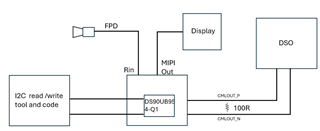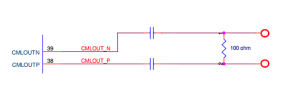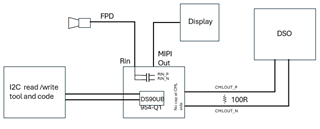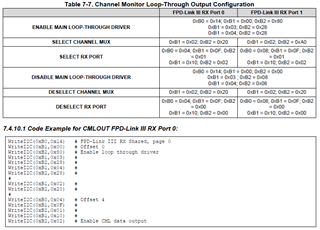Tool/software:
Hi TI Folks,
I want to test FPD signal forward channel quality for that i followed DS90UB954 datasheet I2C code to route Video feed to CML OUT path written below
<aardvark>
<configure i2c="1" spi="0" gpio="0" tpower="1" pullups="1"/>
<i2c_bitrate khz="100"/>
<sleep ms ="100"/>
<i2c_write addr="0x30" count="3" radix="16">0xb0 00 14</i2c_write>
<sleep ms ="100"/>
<i2c_write addr="0x30" count="3" radix="16">0xb1 00 00</i2c_write>
<sleep ms ="100"/>
<i2c_write addr="0x30" count="3" radix="16">0xb2 00 80</i2c_write>
<sleep ms ="100"/>
<i2c_write addr="0x30" count="3" radix="16">0xb1 00 03</i2c_write>
<sleep ms ="100"/>
<i2c_write addr="0x30" count="3" radix="16">0xb2 00 28</i2c_write>
<sleep ms ="100"/>
<i2c_write addr="0x30" count="3" radix="16">0xb1 00 04</i2c_write>
<sleep ms ="100"/>
<i2c_write addr="0x30" count="3" radix="16">0xb2 00 28</i2c_write>
<sleep ms ="100"/>
<i2c_write addr="0x30" count="3" radix="16">0xb1 00 02</i2c_write>
<sleep ms ="100"/>
<i2c_write addr="0x30" count="3" radix="16">0xb2 00 A0</i2c_write>
<sleep ms ="100"/>
<i2c_write addr="0x30" count="3" radix="16">0xb0 00 08</i2c_write>
<sleep ms ="100"/>
<i2c_write addr="0x30" count="3" radix="16">0xb1 00 0F</i2c_write>
<sleep ms ="100"/>
<i2c_write addr="0x30" count="3" radix="16">0xb2 00 01</i2c_write>
<sleep ms ="100"/>
<i2c_write addr="0x30" count="3" radix="16">0xb1 00 10</i2c_write>
<sleep ms ="100"/>
<i2c_write addr="0x30" count="3" radix="16">0xb2 00 02</i2c_write>
<sleep ms ="100"/>
</aardvark>
But i did not get the desire result as i dumped this code in my deserializer as a result the display tuned off but i am not getting signal at CMLOUT_P and CMLOUT_N on DSO i have attached one connection diagram kindly let us know what else should we do to get the signal on DSO.





